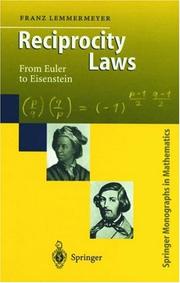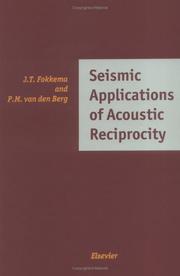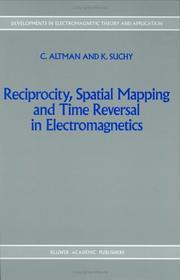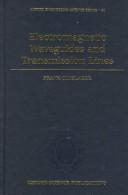| Listing 1 - 6 of 6 |
Sort by
|

ISBN: 3540669574 Year: 2000 Publisher: Berlin Springer
Abstract | Keywords | Export | Availability | Bookmark
 Loading...
Loading...Choose an application
- Reference Manager
- EndNote
- RefWorks (Direct export to RefWorks)

ISBN: 0444890440 Year: 1993 Publisher: Amsterdam Elsevier
Abstract | Keywords | Export | Availability | Bookmark
 Loading...
Loading...Choose an application
- Reference Manager
- EndNote
- RefWorks (Direct export to RefWorks)

ISBN: 0792313399 Year: 1991 Publisher: Dordrecht : Kluwer academic,
Abstract | Keywords | Export | Availability | Bookmark
 Loading...
Loading...Choose an application
- Reference Manager
- EndNote
- RefWorks (Direct export to RefWorks)
Electromagnetism. --- Reciprocity theorems. --- Time reversal.
Book
ISBN: 0511888880 0511550480 Year: 2003 Publisher: Cambridge : Cambridge University Press,
Abstract | Keywords | Export | Availability | Bookmark
 Loading...
Loading...Choose an application
- Reference Manager
- EndNote
- RefWorks (Direct export to RefWorks)
The reciprocity theorem has been used for over 100 years to establish interesting and useful relations between different loading states of a body. This book discusses current and novel uses of reciprocity relations for the determination of elastodynamic fields. The author, who is internationally distinguished for his contributions to theoretical and applied mechanics, presents a novel method to solve for wave fields, shedding new light on the use of reciprocity relations for dynamic fields in an elastic body. The material presented in the book is relevant to several fields in engineering and applied physics. Examples are ultrasonics for medical imaging and non-destructive evaluation, acoustic microscopy, seismology, exploratory geophysics, structural acoustics, and the response of structures to high-rate loads and the determination of material properties by ultrasonic techniques.
Book
ISBN: 9400715293 9400715307 9400795289 Year: 2011 Publisher: Dordrecht : Springer Science,
Abstract | Keywords | Export | Availability | Bookmark
 Loading...
Loading...Choose an application
- Reference Manager
- EndNote
- RefWorks (Direct export to RefWorks)
This long awaited second edition traces the original developments from the 1970s and brings them up to date with new and previously unpublished material to give this work a new lease of life for the early twenty-first century and readers new to the topic. In the winter of 1970-71, Colman Altman had been finding almost exact symmetries in the computed reflection and transmission matrices for plane-stratified magnetoplasmas when symmetrically related directions of incidence were compared. At the suggestion of Kurt Suchy the complex conjugate wave fields, used to construct the eigenmode amplitudes via the mean Poynting flux densities, were replaced by the adjoint wave fields that would propagate in a medium with transposed constitutive tensors, to yield a scattering theorem – reciprocity in k-space -- in the computer output. To prove the result analytically, one had to investigate the properties of the adjoint Maxwell system, and the two independent proofs that followed, in 1975 and 1979, proceeded according to the personal preference of each of the authors. The proof given in this volume, based on the hindsight provided by later results, is much more simple and concise. Later, when media with bianisotropic constitutive tensors were investigated, it was found that conjugate (reciprocal) media and wave fields could be formed by any orthogonal spatial mapping of those in the original problem, after media and fields were reversed in time. The result was still quite general and not limited to stratified systems. The second line of development was to find the link between reciprocity in k-space and Lorentz reciprocity involving currents and sources in physical space. This was done for plane-stratified media by applying the scattering theorem to the plane-wave spectrum of eigenmodes radiated by one current source and reaching the second source. The reverse linkage between Lorentz reciprocity and reciprocity in k-space had already been found. However, this was the first time that the results were presented in a systematic and mathematically well-defined procedure to serve as a tool for solving problems of reciprocity and scattering symmetries. The use of time reversal gives rise to problems of causality when sources are present, but when the interaction between two systems is involved the non-causal effects are irrelevant. The insight gained during these investigations enabled the authors to present many of the earlier theorems and results, both their own and those of others, in a compact and unified approach, which has been the main strength of this book. This new edition has been revised, corrected and updated where necessary to give a complete picture of this interesting topic for the present generation of scientists.
Electromagnetism. --- Reciprocity theorems. --- Time reversal. --- Electromagnetism --- Reciprocity theorems --- Time reversal --- Physics --- Physical Sciences & Mathematics --- Light & Optics --- Electricity & Magnetism --- Electromagnetics --- Reversal, Time --- Reciprocal theorems --- Theorems, Reciprocity --- Physics. --- Optics. --- Electrodynamics. --- Electrical engineering. --- Optics and Electrodynamics. --- Theoretical, Mathematical and Computational Physics. --- Electrical Engineering. --- Nuclear physics --- Quantum theory --- Space and time --- Mathematics --- Magnetic induction --- Magnetism --- Metamaterials --- Computer engineering. --- Classical Electrodynamics. --- Computers --- Design and construction --- Mathematical physics. --- Dynamics --- Light --- Electric engineering --- Engineering --- Physical mathematics

ISBN: 0198564503 9780198564508 Year: 2003 Volume: 51 Publisher: Oxford Clarendon Press
Abstract | Keywords | Export | Availability | Bookmark
 Loading...
Loading...Choose an application
- Reference Manager
- EndNote
- RefWorks (Direct export to RefWorks)
621.372.8 --- 621.372 --- 621.372 Guided propagation of electric oscillations in general --- Guided propagation of electric oscillations in general --- 621.372.8 Waveguides --- Waveguides --- Reciprocity theorems --- Reciprocity theorems. --- Microwave transmission lines --- Wave guides --- Electric conductors --- Electric waves --- Electromagnetic waves --- Gyrators --- Radio --- Transducers --- Reciprocal theorems --- Theorems, Reciprocity --- Mathematics --- Transmission lines, Microwave --- Electric lines --- Telecommunication lines --- Mathematical models --- Equipment and supplies --- Mathematical models. --- Microwave transmission lines - Mathematical models --- Wave guides - Mathematical models
| Listing 1 - 6 of 6 |
Sort by
|

 Search
Search Feedback
Feedback About UniCat
About UniCat  Help
Help News
News